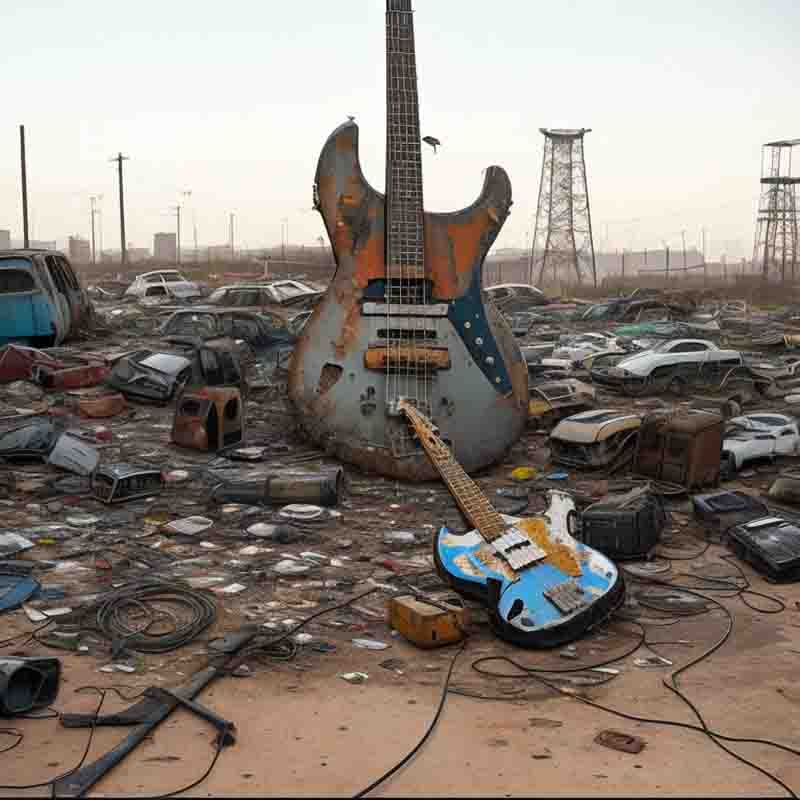The History of Stoner Rock
As a genre that emerged in the 1990s, Stoner Rock embodies the spirit of experimentation and creativity. Its fusion of heavy, fuzz-laden guitar riffs, hypnotic basslines, and groove-laden drumming create a mesmerizing sonic experience that resonates with audiences seeking an escape from the conventional. Stoner Rock draws inspiration from hard rock, heavy metal, and psychedelic rock.

Explore how Stoner Rock has not only shaped modern music but also how it has fostered a global community of devoted fans and artists.
Stoner Rock is a specific subgenre that emerged in the 1990s. It is characterized by a slower tempo, heavy guitar distortion, and a psychedelic or "stoned" atmosphere.
Psychedelic Stoner Blues [Electric Moon]
One-man blues rock outfit Likewolf throws down the gauntlet with his track, "Electric Moon".
✅ Subscribe and become a channel member:
Stoner Rock, often described as a rock guitar based genre that epitomizes the laid-back and hazy aura of its name, traces its roots to the musical landscapes of the late 1960s and early 1970s.
The genre's foundation lies in the fusion of elements from early heavy rock, psychedelic rock, and blues-inspired sounds, and the DIY ethos of Punk Rock creating a distinct sonic experience that resonated with a new generation of listeners seeking a unique musical journey.
Fuzzed Out and Immersed: Stoner Rock Timeline
Stoner rock, dating back to the early 1990s, draws inspiration from various musical genres such as doom metal and a number of other musical forms.
Characterized by distorted guitars, a laid-back groove, and lyrics often influenced by counterculture themes, Stoner Rock is about delivering a distinctive and memorable sonic experience.
| Time Period | Key Events |
|---|---|
| 1960s | Emergence of Heavy Blues and Psychedelic Rock. |
| 1970s | Doom Metal and Proto-Stoner Rock Influences Emerge |
| 1980s | Rise of Independent and Underground Music |
| 1987 | Formation of Influential Bands (e.g., Kyuss) |
| 1990 | Term "Stoner Rock" Coined |
| 1991 | Kyuss Releases "Wretch" |
| 1992 | Sleep Releases "Volume One" |
| 1995 | Monster Magnet's "Dopes to Infinity" Release |
| 1995 | Stoner Rock Gains Popularity in Europe |
| 1998 | Formation of Stoner Rock Sub-Genre and Communities |
| 2000s | Proliferation of Stoner Rock Festivals |
| 2010s | Stoner Rock's Influence on Various Genres Expands |
| 2020s | Ongoing Evolution and Diversification of the Genre |
This timeline provides a broad overview of key events and developments in the history of Stoner Rock, capturing its roots, emergence, and ongoing impact on the music scene.
Riffs, Rituals, and Rebellion: The Heavy Haze of Distortion
The amalgamation of distorted guitars, fuzz-laden tones, deliberate slow tempos, and thematic richness creates a musical journey that transcends the conventional boundaries of rock.
The sonic experience offered by stoner rock is not just about listening; it's about feeling the music, immersing oneself in the layers of sound.
The Late 1960s: The Psychedelic Revolution

While stoner rock has its roots in the underground music scene, its influence has permeated mainstream consciousness, leading to the emergence of both established bands and a continuously evolving community of artists exploring and expanding the boundaries of the genre.
The origins of Stoner Rock can be linked to the psychedelic rock movement of the late 1960s.
Bands like Pink Floyd, The Jimi Hendrix Experience, and Cream experimented with extended jam sessions, mind-altering effects, and a free-flowing musical approach that allowed for improvisation and exploration.
This era's emphasis on musical experimentation laid the groundwork for the experimental nature that defines Stoner Rock.
Heavy Rock and Blues Influence
Concurrently, early hard rock bands such as Black Sabbath and Deep Purple emerged with their own brand of hard-hitting, riff-heavy music.
These bands laid the groundwork for what would later become the distinctive guitar-driven sound of Stoner Rock.
Moreover, the blues-inspired elements in their music added a touch of raw emotion and groove that would eventually become an essential component of the genre.
The 1990s: The Birth of Stoner Rock
While the roots of Stoner Rock were planted in the late 1960s and early 1970s, the genre truly took shape and earned its name in the early 1990s.
California's desert rock scene, particularly in Palm Desert, played a significant role in the genre's development.
Bands like Kyuss, often regarded as one of the pioneers of Stoner Rock, emerged from this scene, incorporating the heavy, desert-inspired vibes into their music.
Characteristics of Stoner Rock
The Stoner Rock genre embraced a slower tempo, often featuring groovy, fuzz-laden guitar riffs, and basslines that created a hypnotic and trance-like atmosphere.
Lyrics often delved into themes of nature, consciousness, and self-exploration, contributing to the genre's introspective and otherworldly vibe.
Stoner Rock is known for its distinct musical characteristics that create a captivating and immersive listening experience.
Drawing inspiration from various musical styles, the genre has developed its own unique sound over the years.
Global Expansion and Subgenre Exploration
As the 1990s progressed, Stoner Rock spread its roots beyond California and gained popularity across the globe.
Bands in Europe, Australia, and beyond embraced the genre, leading to the emergence of various Stoner Rock subgenres.
Stoner Metal, Desert Rock, and Psychedelic Stoner Rock are just a few examples of the diverse musical expressions that stemmed from the genre's initial foundation.
The origins of Stoner Rock lie in the psychedelic experimentation of the 1960s, the heavy rock and blues influences of the 1970s, and the creative momentum of the 1990s desert rock scene.
Today, the genre continues to evolve, captivating new generations of fans while staying true to its roots of musical exploration, groove-laden rhythms, and a distinctively mesmerizing sound.
Heavy and Fuzz-Laden Guitar Riffs

Stoner rock is about finding your own space and enjoying the music. It's not about following trends or being part of a scene." - Brant Bjork of Kyuss.
One of the most recognizable features of Stoner Rock is its emphasis on heavy, downtuned guitar riffs.
These riffs are often saturated with fuzz and distortion, giving them a thick and warm sound.
The low, rumbling tones contribute to the genre's hypnotic and groove-driven nature, creating a sonic landscape that is both powerful and alluring.
Slow and Groovy Tempo
Stoner Rock typically adopts a slow to mid-tempo pace, allowing the music to breathe and giving listeners a chance to absorb the hypnotic rhythms fully.
This deliberate pace contributes to the genre's laid-back and immersive atmosphere, providing a sense of escapism and relaxation.
Extended Instrumental Jams
Reflecting its psychedelic and improvisational roots, Stoner Rock often incorporates extended instrumental jam sessions.
Bands explore musical ideas freely, allowing the music to evolve organically and creating an immersive sonic journey for the listener.
Blues-Inspired Elements

Stoner rock is about being open-minded and accepting of different people and cultures. It's about finding common ground and enjoying the music together." - Dave Catching of Monster Magnet
Stoner Rock frequently draws inspiration from blues music, infusing its compositions with soulful and emotive elements.
The incorporation of bluesy guitar licks and pentatonic scales adds depth and emotion to the genre, evoking a sense of introspection and connection.
Psychedelic Soundscapes
Stemming from its psychedelic rock origins, Stoner Rock embraces the use of effects and sonic experimentation.
Bands often incorporate reverb, delay, and other atmospheric effects to create dreamlike and otherworldly soundscapes that enhance the overall listening experience.
Lyrical Themes of Nature and Exploration
Stoner Rock lyrics often revolve around themes of nature, consciousness, and self-exploration.
The genre's introspective and introspective lyrics encourage listeners to contemplate and connect with their inner thoughts and emotions.
Emphasis on Album Art and Visual Aesthetics
Stoner Rock bands often pay close attention to album artwork and visual aesthetics, aligning them with the genre's psychedelic and imaginative nature.
Album covers frequently feature intricate and trippy artwork that complements the music and enhances the overall experience for fans.
Relaxed and Eclectic Vibes

Stoner rock fans are often seen as being more interested in enjoying the music than in following trends or being part of a scene. They are also often seen as being more open-minded and accepting of different people and cultures.
Overall, Stoner Rock exudes a relaxed and laid-back vibe that allows listeners to lose themselves in the music.
Its diverse influences and willingness to blend various styles create an eclectic and open-minded musical environment that welcomes experimentation and artistic expression.
Stoner Rock's characteristic heavy guitar riffs, slow tempo, extended jams, blues-inspired elements, and psychedelic soundscapes combine to form a genre that is both captivating and introspective.
Its immersive and diverse nature continues to attract a devoted fan base and inspire new generations of musicians seeking to explore the boundaries of musical expression.
Influences of Psychedelic Rock on Stoner Rock
Stoner Rock owes a significant debt to its predecessor, Psychedelic Rock, as the genre's musical roots and ethos are deeply intertwined with the psychedelic movement of the late 1960s and early 1970s.
The influence of Psychedelic Rock on Stoner Rock can be observed in various aspects of its sound, style, and overall aesthetic.
Musical Experimentation and Mind-Altering Effects
Psychedelic Rock was known for pushing musical boundaries and exploring new sonic territories.
It incorporated mind-altering effects, such as reverb, echo, and phasing, to create a trippy and immersive auditory experience.
Stoner Rock, in a similar vein, embraces experimentation with effects, producing a dreamlike soundscape that invites listeners on a journey through altered states of consciousness.
Extended Jam Sessions and Improvisation

Stoner rock music is typically slow-paced and heavy, with a focus on distorted guitars, driving rhythms, and melodic vocals. The lyrics often deal with themes of psychedelia, escapism, and drug use.
Psychedelic Rock bands often engaged in extended jam sessions during live performances, allowing the music to evolve organically and spontaneously.
Stoner Rock musicians inherited this spirit of improvisation, incorporating extended instrumental sections in their compositions.
These jams serve as a canvas for musical exploration, inviting both the musicians and the audience to get lost in the hypnotic grooves.
Emphasis on Atmosphere and Mood
Both Psychedelic Rock and Stoner Rock focus on creating immersive atmospheres that evoke a specific mood or emotional response.
Psychedelic Rock often aimed to transport listeners to alternate dimensions through sound, while Stoner Rock seeks to envelop them in a trance-like and contemplative state.
This shared emphasis on atmosphere contributes to the genre's entrancing and introspective nature.
Spiritual and Psychedelic Themes
Psychedelic Rock was known for its exploration of spiritual and transcendental themes, often inspired by the countercultural movement of the 1960s.
Stoner Rock carries on this tradition, with lyrical themes that touch on introspection, nature, and existentialism.
The focus on inner exploration and consciousness aligns the two genres in their quest for deeper meaning and connection.
Blending Rock with Eastern and World Music Influences
Psychedelic Rock embraced influences from Eastern and world music, incorporating elements like sitars, tablas, and exotic scales into their compositions.
Stoner Rock shares this interest in blending diverse musical elements, resulting in a rich and textured sound that defies easy categorization.
Visual Aesthetics and Artistic Expression

Stoner rock fans often feel like they don't fit in with mainstream society, and they may see aliens as kindred spirits.
Both genres place a strong emphasis on visual aesthetics and artistic expression.
Psychedelic Rock's album covers often featured intricate and surreal artwork, reflecting the mind-expanding nature of the music.
Stoner Rock follows suit, with album art that complements the genre's psychedelic and imaginative sonic landscape.
The influence of Psychedelic Rock on Stoner Rock is evident in the genre's musical experimentation, extended jam sessions, focus on atmosphere, and spiritual themes.
Classic Stoner Rock Albums
Classic Stoner Rock albums are the foundation of the genre and have played a pivotal role in shaping its distinctive sound and identity.
These albums, released during the genre's formative years in the 1990s and early 2000s, continue to be revered by fans and musicians alike.
Here are some of the most influential and iconic Classic Stoner Rock albums:
-
Kyuss - "Blues for the Red Sun" (1992)Often regarded as the quintessential Stoner Rock album, "Blues for the Red Sun" by Kyuss is a groundbreaking release that laid the groundwork for the genre. The album features heavy, fuzz-laden guitar riffs, psychedelic undertones, and the captivating vocals of John Garcia. Tracks like "Green Machine" and "Thumb" showcase the band's distinctive sound and songwriting prowess.
-
Sleep - "Holy Mountain" (1992)"Holy Mountain" is another seminal album in the Stoner Rock canon. Sleep's slow and sludgy approach to the genre, combined with their cryptic and mystical lyrics, created an otherworldly listening experience. The album's epic title track and the monolithic "Dragonaut" have become anthems of the genre.
-
Fu Manchu - "The Action is Go" (1997) Fu Manchu's "The Action is Go" is a high-octane and groove-driven album that exemplifies the energy and attitude of Stoner Rock. With its up-tempo rhythms, catchy hooks, and retro-inspired guitar solos, the album showcases the band's mastery of blending Stoner Rock with punk and hard rock influences.
-
Monster Magnet - "Dopes to Infinity" (1995) "Dopes to Infinity" is a psychedelic and mind-bending journey, featuring Monster Magnet's fusion of heavy riffs and spacey, trippy atmospheres. The album's title track and "Negasonic Teenage Warhead" are prime examples of the band's ability to create an immersive and otherworldly experience.
-
Nebula - "To the Center" (1999) Nebula's "To the Center" showcases the band's ability to incorporate elements of punk and garage rock into the Stoner Rock template. The album's raw and energetic approach, combined with its fuzz-drenched guitar work, solidifies Nebula's place as one of the key players in the genre.
-
Electric Wizard - "Dopethrone" (2000) "Dopethrone" by Electric Wizard is a defining album of Stoner Doom, a subgenre that embraces the heaviness and dark themes of doom metal. The album's crushing guitar tones, droning rhythms, and occult-inspired lyrics make it a must-listen for fans of heavy, brooding Stoner Rock.
-
Clutch - "Clutch" (1995) Clutch's self-titled album features a unique blend of Stoner Rock, blues, and funk influences. With their tight musicianship and the charismatic vocals of Neil Fallon, Clutch's debut album became a classic in the genre, setting them apart as a band with a distinct and diverse sound.
-
Queens of the Stone Age - "Rated R" (2000) While Queens of the Stone Age transcends strict genre categorization, "Rated R" contains elements of Stoner Rock and desert rock that resonate with the genre's fans. The album's hit single "Feel Good Hit of the Summer" and tracks like "The Lost Art of Keeping a Secret" exemplify the band's innovative approach to rock music.
-
John Garcia & The Band Of Gold (2018) The Kyuss legend and creator of truly desert rock cornerstones such as Unida, Slo-Burn, Hermano and Vista Chino returned in his next incarnation, John Garcia & The Band Of Gold. He is one of the remaining true and authentic rock singers. A feast for Stoner enthusiasts
Exploring the Stoner Rock Subgenre

Stoner rock guitars are typically characterized by their heavy sound and their use of distortion. They often have humbucker pickups, which produce a thicker and fuller sound than single-coil pickups. Stoner rock guitarists also often use downtuning, which lowers the pitch of the strings, giving the guitar a heavier sound.
Stoner Rock, as a genre, has diversified over the years, giving rise to various subgenres that each offer a unique take on the core elements of heavy, groove-laden music.
Exploring the Stoner Rock subgenre reveals a rich tapestry of sounds and styles that cater to diverse musical preferences.
Here are some of the prominent Stoner Rock subgenres and their defining characteristics:
Stoner Doom
Stoner Doom is a fusion of Stoner Rock's groovy rhythms and the crushing heaviness of traditional Doom Metal.
Characterized by slow tempos, downtuned guitars, and an emphasis on dark and foreboding atmospheres, Stoner Doom delves into themes of despair, sorrow, and the apocalyptic.
Bands like Electric Wizard, Sleep, and YOB are iconic representatives of this subgenre.
Desert Rock
Desert Rock, also known as Desert Stoner Rock, is heavily associated with California's desert rock scene, particularly in Palm Desert.
It incorporates elements of psychedelia and blues, creating a sound that reflects the vast landscapes of the desert.
Bands like Kyuss, Fu Manchu, and Brant Bjork are pioneers of Desert Rock, shaping the subgenre's identity with their laid-back and groove-driven approach.
Psychedelic Stoner Rock
Psychedelic Stoner Rock embraces the psychedelic influences of the genre to a greater extent.
It incorporates more extensive use of effects, trippy soundscapes, and experimental song structures.
This subgenre often blurs the lines between Stoner Rock and Psychedelic Rock, creating a mind-expanding and immersive listening experience.
Bands like Monster Magnet and Earthless exemplify the psychedelic aspects of Stoner Rock.
Stoner Metal
Stoner Metal leans more towards the metal side of the spectrum, infusing Stoner Rock's grooves with the heaviness and aggression of traditional metal.
It features powerful guitar riffs, prominent basslines, and thunderous drumming.
Bands like High on Fire, Red Fang, and Baroness are notable representatives of the Stoner Metal subgenre.
Sludge Metal
While not purely Stoner Rock, Sludge Metal shares some commonalities with the genre.
It is characterized by its slow, down-tuned sound, aggressive vocals, and raw, abrasive textures.
Sludge Metal often incorporates elements of doom and punk, resulting in a gritty and aggressive sonic experience.
Bands like Eyehategod, Melvins, and Crowbar exemplify the sludgy aspects of this subgenre.
Stoner Blues
Stoner Blues, as the name suggests, marries Stoner Rock with traditional blues influences.
This subgenre retains the heavy, fuzz-laden guitars of Stoner Rock while infusing them with the emotive and soulful elements of blues music.
Stoner Blues bands like Radio Moscow and All Them Witches incorporate bluesy guitar solos and expressive vocals into their compositions.
Instrumental Stoner Rock
Instrumental Stoner Rock focuses on crafting mesmerizing musical landscapes without the need for vocal accompaniment.
This subgenre emphasizes extended instrumental jams, allowing the music to speak for itself.
Bands like Karma to Burn and Russian Circles are known for their captivating instrumental compositions.
exploring the Stoner Rock subgenre reveals a diverse and expansive world of heavy and groovy music.
Each subgenre adds its own distinct flavors and influences to the core elements of Stoner Rock, offering a wide array of sonic experiences for enthusiasts of heavy and psychedelic sounds.
Whether fans seek the crushingly heavy tones of Stoner Doom or the mind-bending psychedelia of Psychedelic Stoner Rock, the subgenres of Stoner Rock present a musical journey full of exploration and sonic adventure.
Top Stoner Rock Guitarists

Stoner rock guitarists often use high gain amps and pedals to create a thick, distorted sound. This is in contrast to other genres of rock music, such as punk rock, which often use lower gain amps and pedals to create a sharper, more aggressive sound.
Stoner Rock is a genre that places significant emphasis on guitar-driven music, and as such, it has produced a plethora of talented guitarists who have left a lasting impact on the genre.
These guitarists have contributed to the distinctive sound and style of Stoner Rock, creating mesmerizing and memorable guitar work that resonates with fans worldwide.
Here are some of the top Stoner Rock guitarists known for their exceptional skills and contributions to the genre:
-
Josh Homme (Kyuss, Queens of the Stone Age) Josh Homme is a seminal figure in the Stoner Rock movement, having been a founding member of Kyuss, one of the genre's pioneers. His distinctive playing style, characterized by heavy, fuzz-laden riffs and melodic solos, has helped shape the sound of Stoner Rock. Homme's work with Queens of the Stone Age further solidifies his reputation as a masterful guitarist.
-
Brant Bjork (Kyuss, Brant Bjork and the Low Desert Punk Band)Brant Bjork's drumming prowess is well-known from his time with Kyuss, but he is also an accomplished guitarist. As a member of Kyuss, his guitar work was crucial in shaping the sound of the band. In his solo career with Brant Bjork and the Low Desert Punk Band, he further showcases his bluesy and soulful guitar skills.
-
Matt Pike (Sleep, High on Fire)Matt Pike's distinctive guitar playing has left an indelible mark on the Stoner Rock and Doom Metal scenes. As the guitarist and vocalist for Sleep, his heavy and sludgy riffing helped define Stoner Doom. In High on Fire, he showcases his virtuosic guitar work, incorporating elements of thrash and sludge metal into the mix.
-
Ed Mundell (Monster Magnet, The Atomic Bitchwax)Ed Mundell's guitar work with Monster Magnet and The Atomic Bitchwax has been highly influential in the Stoner Rock and Psychedelic Stoner Rock subgenres. His ability to infuse psychedelic elements into heavy riffs and captivating solos has earned him recognition as a top guitarist in the genre.
-
Scott "Wino" Weinrich (The Obsessed, Spirit Caravan, Saint Vitus)Scott "Wino" Weinrich is a veteran of the Doom Metal and Stoner Rock scenes, having played with bands like The Obsessed, Spirit Caravan, and Saint Vitus. His soulful and emotive guitar work, combined with his distinct vocal style, has made him a revered figure in the genre.
-
Nick Oliveri (Kyuss, Queens of the Stone Age)Nick Oliveri's bass guitar contributions to Kyuss and Queens of the Stone Age have been instrumental in shaping the groovy and heavy sound of Stoner Rock. His powerful basslines complement the guitar work, adding depth and groove to the music.
These top Stoner Rock guitarists have played pivotal roles in defining the genre's sound and style.
Their exceptional skills and innovative approaches to guitar playing have left a lasting impact on the genre, inspiring new generations of musicians and contributing to the enduring popularity of Stoner Rock within the wider rock music landscape.
Iconic Stoner Rock Festivals

One of the basic characteristics of stoner rock is a rather leisurely tempo that extends at most to midtempo. Also typical are frequent contrasts of soft and hard passages.
The sound is usually heavily distorted, very groovy and bass-heavy, has melodic vocals and is often produced retro-like.
Stoner Rock festivals are gatherings that celebrate the spirit and sound of the genre, bringing together fans and musicians from around the world.
These festivals offer a unique and immersive experience, featuring performances by some of the most influential bands in the genre and fostering a sense of community among Stoner Rock enthusiasts.
Here are some of the most iconic Stoner Rock festivals that have become synonymous with the genre
Desertfest (London, Berlin, New York, Antwerp)
Desertfest is one of the most renowned Stoner Rock festivals, taking place in multiple locations around the world.
The original London edition, held annually in Camden, showcases a diverse lineup of Stoner Rock, Doom Metal, and Psychedelic Rock bands.
The festival has since expanded to Berlin, New York, and Antwerp, cementing its status as a global celebration of heavy and groovy music.
Stoned and Dusted (California, USA)
Stoned and Dusted is a desert festival that captures the essence of Stoner Rock in its natural habitat.
Held in the Mojave Desert, California, the festival features performances by influential Stoner Rock bands against a backdrop of stunning desert landscapes.
It has become an iconic event that celebrates the genre's connection to the deserts that inspired its early pioneers.
Psycho Las Vegas (Las Vegas, USA)
Psycho Las Vegas is a multi-genre music festival that includes a substantial lineup of Stoner Rock, Doom Metal, and other heavy genres.
Held in the vibrant city of Las Vegas, the festival attracts a diverse audience of rock music enthusiasts.
It provides a unique experience where festival-goers can enjoy a mix of world-class music performances and the glitzy entertainment of Sin City.
Roadburn Festival (Tilburg, Netherlands)
Roadburn Festival is renowned for its dedication to pushing the boundaries of heavy music, including Stoner Rock, Doom Metal, and experimental genres.
Held annually in Tilburg, the Netherlands, the festival features a carefully curated lineup that showcases both established and emerging artists, making it a haven for fans seeking adventurous and boundary-pushing music.
Up in Smoke Festival (Pratteln, Switzerland)
Up in Smoke Festival is a premier Stoner Rock and Doom Metal event held in Pratteln, Switzerland.
With its heavy lineup and a focus on delivering an authentic and immersive experience, the festival has become a must-attend event for Stoner Rock enthusiasts in Europe and beyond.
Keep It Low Festival (Munich, Germany)
Keep It Low Festival, held in Munich, Germany, embraces the heavy and groovy side of Stoner Rock and related genres.
With its atmospheric setting and a roster of international bands, the festival attracts fans from all over Europe to revel in the genre's mesmerizing sound.
These iconic Stoner Rock festivals serve as important platforms for bands to showcase their talents and for fans to immerse themselves in the genre's unique atmosphere.
They foster a sense of community among Stoner Rock enthusiasts, allowing them to connect, celebrate the music they love, and discover new artists.
These festivals continue to contribute to the growing popularity and global appeal of Stoner Rock, ensuring that the genre remains a vibrant and vital part of the rock music landscape.
Stoner Rock's Impact on Modern Music
Stoner Rock, with its distinctive blend of heavy, groovy, and psychedelic sounds, has had a significant impact on modern music across various genres.
Over the years, the influence of Stoner Rock has transcended its underground origins, shaping and inspiring musicians and bands in diverse ways.
Here are some key aspects of Stoner Rock's impact on modern music:
Revival of Vintage Rock Sounds
Stoner Rock's embrace of vintage rock sounds, such as fuzz-laden guitar riffs and bluesy influences, has sparked a revival of interest in classic rock and early heavy metal tones.
Many modern bands and artists now incorporate elements of Stoner Rock's signature sound, infusing their music with retro vibes and a love for the '70s and '80s rock era.
Pioneering the Heavy Underground Scene
Stoner Rock played a pivotal role in pioneering and fostering the heavy underground music scene.
As the genre gained popularity in the '90s, it paved the way for the emergence of other heavy and experimental subgenres, such as Doom Metal, Sludge Metal, and Psychedelic Rock.
These subgenres continue to thrive today, thanks in part to Stoner Rock's influence.
Expanding the Psychedelic Music Movement
Stoner Rock's psychedelic elements and its connections to the countercultural movements of the '60s and '70s have contributed to the expansion of the modern psychedelic music movement.
Today, bands from various genres incorporate psychedelic elements into their music, creating a diverse and vibrant psychedelic music scene.
Blurring Genre Boundaries
Stoner Rock's openness to experimentation and its willingness to draw influences from various musical styles have inspired a generation of musicians to break free from conventional genre boundaries.
The genre's fusion of heavy rock, blues, and psychedelic elements has encouraged artists to explore new sonic territories and create music that defies easy categorization.
Impact on Metal and Alternative Music
Stoner Rock's fusion of heavy and groovy elements has left an imprint on the metal and alternative music scenes.
Many bands in these genres have incorporated Stoner Rock's hypnotic rhythms and guitar-driven sound, adding depth and complexity to their music.
Influence on Visual Aesthetics
Stoner Rock's emphasis on album artwork and visual aesthetics has influenced album covers and artistic direction in various music genres.
The trippy, psychedelic, and imaginative artwork commonly associated with Stoner Rock has become a staple for many bands and artists seeking to create an immersive visual experience for their listeners.
Creation of a Global Stoner Rock Community
Stoner Rock's impact extends beyond music; it has fostered a global community of devoted fans, bands, and festivals that celebrate the genre's spirit.
This sense of community and camaraderie has helped the genre maintain its relevance and popularity over the years.
Stoner Rock's impact on modern music is far-reaching and multifaceted.
Its signature sound and ethos have contributed to the revival of vintage rock sounds, the expansion of the psychedelic music movement, and the blurring of genre boundaries.
Furthermore, Stoner Rock's influence on the heavy underground scene and its role in creating a global community of fans and musicians demonstrate its lasting significance and enduring appeal in the contemporary music landscape.
Stoner Rock's Lyrical Themes
Stoner Rock's lyrical themes play a crucial role in creating the genre's introspective and immersive atmosphere.
The genre's lyrics often delve into a range of subjects that reflect its countercultural and psychedelic roots.
While Stoner Rock's themes can vary from band to band, several common lyrical motifs can be found within the genre:
Nature and Exploration
Stoner Rock frequently explores themes of nature and the great outdoors.
Lyrics often evoke images of vast landscapes, deserts, mountains, and the beauty of nature.
The genre's connection to California's desert rock scene, in particular, has influenced many bands to draw inspiration from the natural world.
Consciousness and Self-Exploration
Stoner Rock often delves into themes of self-exploration, introspection, and consciousness.
The genre's connection to psychedelic music has inspired lyrics that encourage listeners to explore their inner thoughts and emotions, sometimes delving into altered states of consciousness.
Spiritual and Mystical Themes
Some Stoner Rock bands touch on spiritual and mystical themes, drawing from the countercultural movements of the '60s and '70s. Lyrics may explore spirituality, transcendence, and the search for higher meaning.
Escapism and Freedom
Many Stoner Rock lyrics embody a sense of escapism and freedom. The genre's laid-back and groovy sound, along with themes of nature and exploration, can create a sense of liberation and release from the constraints of daily life.
Marijuana Culture
As the name "Stoner Rock" suggests, the genre has strong ties to marijuana culture.
Some lyrics reference the use of cannabis, often in a positive and celebratory light, aligning with the countercultural associations of the genre.
Existential and Philosophical Reflections
Stoner Rock lyrics occasionally delve into existential and philosophical reflections.
These themes may ponder life's meaning, human existence, and the universe's mysteries, reflecting the genre's introspective nature.
Socio-Political Commentary
While not as prevalent as other themes, some Stoner Rock bands incorporate socio-political commentary into their lyrics.
These songs may touch on issues such as environmental concerns, social justice, or the consequences of modern society.
Science Fiction and Fantasy
Some Stoner Rock bands draw inspiration from science fiction and fantasy themes.
Lyrics may explore imaginary worlds, outer space, or fantastical narratives, adding an element of escapism and adventure to the genre.
It's essential to note that Stoner Rock's lyrical themes are diverse, and not all bands within the genre adhere to the same themes.
Some bands may choose to focus on specific topics, while others may explore a wide range of themes.
Regardless of the lyrical content, Stoner Rock's emphasis on introspection, nature, and the exploration of consciousness contributes to the genre's unique and immersive appeal.
Notable Stoner Rock Drummers

Stoner rock drummers are a unique breed. They are known for their heavy riffs, driving beats, and laid-back attitude.
Stoner Rock's distinctive rhythm section, anchored by talented drummers, is a critical component of the genre's groovy and immersive sound.
These drummers often bring a unique style and energy to the music, contributing to the hypnotic and trance-like nature of Stoner Rock.
Here are some notable Stoner Rock drummers who have made significant contributions to the genre:
-
Alfredo Hernández (Kyuss, Queens of the Stone Age)Alfredo Hernández, also known as "Alfredo the Legendary," was the original drummer for Kyuss, one of the pioneering bands of Stoner Rock. His drumming played a crucial role in establishing the genre's signature rhythmic feel. He also briefly joined Queens of the Stone Age during their early years, further solidifying his place in Stoner Rock history.
-
Brant Bjork (Kyuss, Fu Manchu, Brant Bjork and the Low Desert Punk Band)In addition to his role as a guitarist, Brant Bjork was the drummer for Kyuss during their early years. His distinctive drumming style, characterized by its laid-back and groovy rhythms, contributed to Kyuss' unique sound. After Kyuss disbanded, Bjork went on to play drums in Fu Manchu and later pursued a successful solo career with Brant Bjork and the Low Desert Punk Band.
-
Chris Hakius (Sleep, OM)Chris Hakius was the original drummer for Sleep, one of the pioneers of Stoner Doom. His powerful and steady drumming, combined with Sleep's slow and crushing sound, helped define the aesthetics of Stoner Doom Metal. After Sleep disbanded, Hakius went on to form the band OM, where he continued to showcase his distinctive drumming style.
-
Dale Crover (Melvins)While the Melvins' music encompasses various genres, their influence on the development of Stoner Rock is significant. Dale Crover's drumming with the Melvins, known for its versatility and dynamic range, has inspired generations of drummers in various heavy music scenes.
-
Brann Dailor (Mastodon)Although Mastodon's music spans multiple genres, they incorporate elements of Stoner Rock into their sound. Brann Dailor's drumming with Mastodon is marked by its technical proficiency and progressive approach, adding a unique dimension to the band's blend of heavy styles.
-
Scott Reeder (Kyuss, The Obsessed, Sun and Sail Club)Scott Reeder served as Kyuss' bassist during their later years but also contributed as a drummer during the band's early days. His drumming style in Kyuss is characterized by its tight and rhythmic precision. After Kyuss, he went on to play drums for The Obsessed and formed the band Sun and Sail Club.
-
Jon Theodore (Queens of the Stone Age, The Mars Volta)Jon Theodore's drumming with Queens of the Stone Age during their album "Songs for the Deaf" showcased his technical prowess and powerful playing. His contributions added a dynamic and hard-hitting element to the band's sound.
These notable Stoner Rock drummers, along with many others, have left an indelible mark on the genre.
Their skillful and groove-oriented drumming has been instrumental in shaping Stoner Rock's rhythmic foundation, contributing to the genre's enduring appeal and its status as a vibrant force within the broader rock music landscape.
Stoner Rock's Global Appeal
Stoner Rock's global appeal is a testament to the genre's unique and immersive sound, as well as its ability to resonate with audiences across different cultures and regions.
The genre's distinct characteristics, coupled with its countercultural and transcendent themes, have led to its widespread popularity and enduring influence.
Here are some key factors contributing to Stoner Rock's global appeal:
Universality of Groove
Stoner Rock's emphasis on heavy, groove-laden rhythms and hypnotic guitar riffs transcends language barriers.
The genre's infectious and head-nodding beats have a universal appeal, drawing listeners from all corners of the world who share a love for music that moves the body and the soul.
Introspective and Relatable Themes
Stoner Rock's lyrical themes often explore introspection, nature, and self-exploration, which are universally relatable.
The genre's contemplative and spiritual nature resonates with people from various cultural backgrounds, making it an inclusive and meaningful musical experience.
Connection to Nature and the Outdoors
Stoner Rock's fascination with nature and the outdoors strikes a chord with listeners worldwide.
The genre's references to deserts, mountains, and open spaces evoke a sense of wanderlust and appreciation for the natural world, which transcends cultural boundaries.
Escape and Liberation
Stoner Rock's themes of escapism and liberation hold cross-cultural appeal.
The genre's ability to transport listeners to a different state of mind, away from the stresses of daily life, is something that people from all walks of life can appreciate and find solace in.
Countercultural Spirit
The genre's countercultural roots, drawing inspiration from the '60s and '70s, evoke a spirit of rebellion and nonconformity that resonates with audiences worldwide.
Stoner Rock's connection to the broader countercultural movements of the past gives it a sense of timelessness and relevance.
Fusion of Genres
Stoner Rock's willingness to blend elements of various genres, such as psychedelic, blues, and doom, allows it to appeal to fans of diverse musical backgrounds.
Its versatility and openness to experimentation attract listeners who appreciate music that defies strict genre categorization.
Global Community and Festivals
Stoner Rock's global appeal is further enhanced by the sense of community it fosters among fans worldwide.
Festivals like Desertfest, Stoned and Dusted, and Psycho Las Vegas bring together fans and bands from different countries, creating a shared experience and a sense of belonging to a global Stoner Rock community.
Internet and Digital Platforms
The advent of the internet and digital music platforms has facilitated the global dissemination of Stoner Rock music.
Fans from all corners of the world can access and discover bands from different countries, leading to the genre's growing popularity and reach.
Stoner Rock's global appeal is a result of its universal grooves, relatable themes, and cross-cultural spirit.
The genre's ability to create an immersive and introspective musical experience, along with its inclusivity and sense of community, has helped it transcend geographical and cultural boundaries.
Stoner Rock's global reach continues to grow, ensuring that its heavy, groovy, and psychedelic sounds will continue to resonate with listeners across the globe for years to come.
Women in Stoner Rock Bands
While the music industry has historically been male-dominated, women have been making significant strides in various genres, including Stoner Rock.
Over the years, women have played an essential role in shaping the sound and culture of Stoner Rock bands, both as musicians and vocalists.
Here are some key points about the contributions and representation of women in Stoner Rock:
Musicianship and Skill
Women in Stoner Rock bands have demonstrated exceptional musicianship and skill, proving themselves as talented instrumentalists on guitar, bass, drums, and keyboards.
Their proficiency and creativity have enriched the genre and broken down gender stereotypes in the male-dominated world of rock music.
Vocal Presence
Women have not only been instrumentalists in Stoner Rock bands but have also taken up prominent roles as lead vocalists.
Their powerful and soulful voices bring a unique dimension to the genre's sound, adding depth and emotional resonance to the music.
Breaking Stereotypes
Women in Stoner Rock are breaking stereotypes and challenging traditional gender roles within the music industry.
Their presence and visibility in the genre empower other aspiring female musicians, encouraging them to pursue their passion for music fearlessly.
Diverse Representation
Women in Stoner Rock come from diverse backgrounds and identities, representing various cultures and perspectives.
Their presence contributes to a more inclusive and diverse Stoner Rock community that embraces people of all genders and backgrounds.
Pioneering Bands
Several pioneering bands with women members have been instrumental in shaping the landscape of women in Stoner Rock.
Bands like Windhand, Royal Thunder, Acid King, and Ruby the Hatchet, among others, have garnered critical acclaim and a dedicated fan base, proving that women can lead and excel in the genre.
Fostering a Supportive Community
Women in Stoner Rock bands have fostered a supportive community within the genre, both among fellow musicians and fans.
This sense of camaraderie and mutual support helps create a more inclusive and welcoming environment for women in Stoner Rock.
Role Models for Future Generations
Women in Stoner Rock bands serve as role models for aspiring musicians, demonstrating that passion, skill, and determination can lead to success in the music industry.
Their visibility encourages young women to pursue their musical aspirations and follow their creative instincts.
Challenging Misconceptions
Women in Stoner Rock bands challenge misconceptions about the genre being exclusively male-driven.
Their presence highlights the diversity and inclusivity within Stoner Rock, debunking stereotypes that may have been associated with the genre in the past.
Women's contributions to Stoner Rock bands have been significant and impactful.
They have brought a fresh perspective to the genre, breaking down barriers, and enriching the music with their skill and creativity.
Women in Stoner Rock serve as role models, inspiring future generations of musicians and contributing to a more diverse and vibrant Stoner Rock community.
As the genre continues to evolve, their presence ensures that Stoner Rock remains an inclusive and forward-thinking space within the broader rock music landscape.
Stoner Rock's Aesthetics in Album Art
Stoner Rock's album art plays a crucial role in capturing the genre's vibe and ethos.
The visual aesthetics of Stoner Rock album covers often reflect the genre's trippy, psychedelic, and countercultural roots.
These artworks not only complement the music but also serve as visual gateways into the world of Stoner Rock.
Here are some key elements of Stoner Rock's aesthetics in album art:
Psychedelic Artwork
Psychedelic elements are a hallmark of Stoner Rock album art.
Vibrant and abstract patterns, kaleidoscopic designs, and surreal imagery are often used to create visually captivating album covers.
These trippy visuals align with the genre's connection to psychedelic music and its countercultural influences.
Nature and Landscapes
Many Stoner Rock album covers incorporate imagery of nature and landscapes.
Desert landscapes, mountains, and vast open spaces often feature prominently, reflecting the genre's fascination with the great outdoors and its connection to the desert rock scene.
Cosmic Themes
Cosmic and outer space themes are common in Stoner Rock album art.
Imagery of stars, planets, and celestial bodies evoke a sense of cosmic wonder and exploration, aligning with the genre's transcendent and mind-expanding themes.
Use of Earthy Tones
Earthy and warm color palettes, such as browns, oranges, and deep reds, are frequently used in Stoner Rock album art.
These colors evoke a sense of warmth and complement the genre's connection to nature and the desert landscape.
Vintage and Retro Vibes
Stoner Rock album art often embraces vintage and retro aesthetics.
Fonts reminiscent of '70s rock posters, grainy textures, and distressed elements create a nostalgic and classic vibe, paying homage to the genre's historical influences.
Symbolism and Iconography
Symbolism and iconography are frequently employed in Stoner Rock album covers.
Elements such as skulls, trippy eyes, sacred geometry, and occult symbols add depth and intrigue to the visual storytelling, connecting with the genre's mystical and introspective themes.
Hand-Drawn Artwork
Some Stoner Rock bands opt for hand-drawn or illustrated artwork, emphasizing the DIY and artisanal aspects of the genre.
These hand-crafted visuals add a personal touch and contribute to the genre's grassroots and underground ethos.
Album as Art Object
Stoner Rock album covers are often treated as art objects in their own right.
Fans appreciate the effort and creativity put into the visuals, making album covers collectible and cherished items among the genre's enthusiasts.
Stoner Rock's album art is a rich and diverse visual tapestry that reflects the genre's trippy, psychedelic, and countercultural identity.
The album covers act as visual companions to the music, inviting listeners into a world of cosmic exploration, nature's beauty, and mind-expanding experiences.
Stoner Rock's aesthetics in album art contribute to the genre's immersive and evocative nature, making the visual journey as integral to the experience as the music itself.
The Resurgence of Vinyl in the Stoner Rock Community
The resurgence of vinyl records in the music industry has been particularly significant within the Stoner Rock community.
Despite the prevalence of digital music formats, Stoner Rock enthusiasts have embraced vinyl as a preferred medium for experiencing their favorite music.
This resurgence is driven by several factors that align with the genre's ethos and the preferences of its dedicated fanbase.
Here's why vinyl has experienced a revival within the Stoner Rock community:
Vintage and Analog Appeal
Stoner Rock's connection to the '70s and its vintage influences make vinyl a natural fit for the genre.
Vinyl records offer an analog and warm sound quality that complements the heavy, groovy, and psychedelic nature of Stoner Rock music.
Fans appreciate the nostalgic experience of spinning vinyl, harkening back to the golden era of rock and roll.
Album Art and Visual Aesthetics
Stoner Rock's emphasis on visual aesthetics in album art aligns with the larger-format canvas of vinyl records.
The larger album covers allow for more detailed and captivating artwork, enhancing the overall listening experience and offering fans an opportunity to immerse themselves in the band's visual universe.
Physical Collectible Items
Vinyl records hold a tangible and collectible quality that appeals to Stoner Rock fans.
Owning a physical copy of an album allows enthusiasts to build a curated collection that reflects their musical taste and passion for the genre.
The act of flipping through record stores or online vinyl retailers is an experience in itself, bringing joy to collectors.
Ritualistic Listening Experience
Stoner Rock's introspective and immersive nature makes vinyl an ideal medium for creating a ritualistic listening experience.
The act of placing a vinyl record on the turntable, carefully setting the needle, and sitting back to absorb the music creates a deeper connection with the music and allows for a more focused and mindful listening session.
Limited Edition Releases
Many Stoner Rock bands and record labels release exclusive and limited edition vinyl versions of albums.
These special releases often feature unique colored vinyl, gatefold covers, and bonus artwork or inserts.
The allure of limited editions appeals to collectors and creates a sense of exclusivity within the community.
Supporting Independent Labels
The Stoner Rock community places significant value on supporting independent and underground music.
Purchasing vinyl directly from bands or independent labels is seen as a way to directly support the artists and contribute to the growth of the genre.
Community and Rituals
The Stoner Rock community places emphasis on sharing and celebrating music collectively.
Vinyl records often become a centerpiece for gatherings, listening parties, and vinyl-spinning rituals, fostering a sense of camaraderie among fans.
The resurgence of vinyl in the Stoner Rock community is more than just a nostalgic throwback; it aligns perfectly with the genre's vintage and analog appeal, as well as its emphasis on visual aesthetics and immersive listening experiences.
Vinyl records have become cherished collectibles and ritualistic items within the community, providing a deeper connection between the music and its devoted fanbase.
As Stoner Rock continues to thrive, vinyl's enduring allure ensures that it remains an integral part of the genre's culture and identity.
Exploring Stoner Rock's Underground Scene
While Stoner Rock has gained some mainstream recognition over the years, its heart and soul lie in the underground music scene.
The underground Stoner Rock community is a vibrant and diverse subculture that embraces the genre's countercultural spirit, DIY ethos, and a deep passion for heavy, groovy, and psychedelic music.
Here are some key aspects of exploring Stoner Rock's underground scene:
Independent and DIY Culture
The underground Stoner Rock scene thrives on the principles of independence and DIY (Do-It-Yourself) culture.
Many bands self-produce their music, book their own tours, and release albums through independent labels or self-released formats. This DIY approach allows artists to retain creative control and connect directly with their fanbase.
Underground Venues and Shows
Stoner Rock bands often perform in intimate and unconventional venues, including small clubs, DIY spaces, warehouses, and underground festivals.
These venues offer an up-close and personal experience, creating an intimate connection between the bands and their fans.
Cassette and Vinyl Releases
Within the underground scene, physical formats like cassettes and vinyl records are highly valued.
Many bands release limited-edition cassettes or vinyl records that become sought-after collectibles among fans.
Cult Followings and Fan Communities
Underground Stoner Rock bands often develop cult followings among dedicated fans.
The genre's niche appeal fosters tight-knit fan communities that actively support their favorite artists, attend shows, and share their passion for the music.
International Connections
The underground Stoner Rock scene transcends borders, connecting bands and fans from around the world.
Through online platforms, social media, and underground festivals, international connections are forged, creating a global community of Stoner Rock enthusiasts.
Zines and Webzines
Zines and webzines dedicated to Stoner Rock play a vital role in promoting underground bands and spreading the word about new releases and shows.
These grassroots publications serve as essential resources for discovering emerging talent and connecting fans with the underground scene.
Collaboration and DIY Collaborative Releases
Bands in the underground Stoner Rock scene often collaborate with one another on split releases, tribute albums, and compilation records.
These collaborative efforts strengthen the sense of community and camaraderie within the genre.
Festivals and DIY Events
Underground Stoner Rock festivals and DIY events provide platforms for emerging bands to showcase their music.
These gatherings celebrate the genre's spirit of togetherness and give fans the chance to experience an eclectic lineup of underground talent.
Exploring Stoner Rock's underground scene unveils a rich and diverse subculture that embraces independence, DIY values, and a deep passion for heavy and psychedelic music.
The underground scene remains true to the genre's countercultural roots, fostering connections between bands, fans, and zines, while providing a platform for emerging talent to showcase their art.
As the heart of Stoner Rock's community, the underground scene continues to fuel the genre's creativity, diversity, and enduring appeal.
Best Places to Discover Stoner Rock Music
For Stoner Rock enthusiasts looking to explore and discover new music within the genre, there are several platforms and resources that cater to the diverse and ever-expanding Stoner Rock scene.
These platforms provide opportunities to find emerging artists, underground releases, and connect with like-minded fans.
Here are some of the best places to discover new Stoner Rock music:
Stoner Rock Festivals and Events
Attending Stoner Rock festivals and events is a great way to discover new bands and experience the genre's live performances.
These gatherings often showcase a diverse lineup of established and emerging artists, giving fans the opportunity to explore the scene's latest offerings.
Record Stores and Vinyl Retailers
Independent record stores and vinyl retailers often have dedicated Stoner Rock sections where fans can find both classic albums and new releases.
Visiting these stores provides a tactile experience of flipping through vinyl records and discovering hidden gems.
Underground Record Labels
Exploring record labels that specialize in Stoner Rock and related genres can lead to the discovery of exciting new bands.
Many underground labels focus on promoting emerging artists and releases that might not be as widely known.
By tapping into these diverse platforms and resources, Stoner Rock fans can continuously explore and discover new music, supporting both established and emerging artists, and remaining connected to the vibrant and ever-evolving Stoner Rock community.
In conclusion, Stoner Rock is a captivating and dynamic genre that has carved out a unique niche within the broader landscape of rock and metal music.
With its roots in the countercultural movements of the '60s and '70s, Stoner Rock brings together elements of heavy rock, psychedelic sounds, and a DIY ethos, creating a distinct and immersive musical experience.
As we've explored various facets of Stoner Rock, it's evident that the genre's appeal extends far beyond its signature heavy riffs and groovy rhythms.
Stoner Rock's themes of introspection, connection to nature, and transcendence resonate with fans on a profound level, fostering a strong and dedicated community.
The genre's underground scene plays a pivotal role in shaping the Stoner Rock culture, promoting DIY values, and providing a platform for emerging talent.
Through zines, webzines, independent record labels, and intimate venues, fans can discover new bands and actively participate in the growth of the genre.
Stoner Rock's fusion with other genres, such as Doom Metal, Psychedelic Rock, and Punk, has led to the emergence of exciting subgenres that push the boundaries of the genre's sound.
This spirit of experimentation and openness to new influences keeps Stoner Rock fresh and continuously evolving.
Stoner Rock: FAQ
Are you curious about music, art, technology, fashion, lifestyle, and beer?
If so, then you need to subscribe to the free Likewolf newsletter.
100% privacy. When you sign up, we'll keep you posted.
Prog Vibes Await
The History and Influence of Progressive Rock
